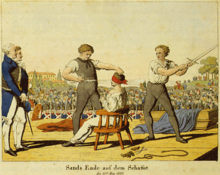Guiding sword
| Guiding sword | |
|---|---|

|
|
| Information | |
| Weapon type: | sword |
| Designations: | Executioner's sword |
| Use: | civil / judicial weapon |
| Creation time: | Late 13th century |
| Working time: | until now |
| Region of origin / author: |
Europe , urban communities |
| Distribution: | Europe |
| Overall length: | approx. 110 cm, varying |
| Blade length: | approx. 80–90 cm, varying |
| Blade width: | approx. 5 cm, varying |
| Handle: | Wood, horn, metal |
| Particularities: | rounded tip ( place ), pierced with holes, blade often with symbolic engravings (wheel, gallows etc.), religious sayings, no or short crossguards |
| Lists on the subject | |
As a sword of a two Hands-run is sword called that in the Middle Ages and into the modern era to decapitation was used by convicts.

description
The person to be beheaded sat upright on a special straightening chair with armrests, a low backrest and often attached belts for fixation. In contrast to the two-handed sword, the blade was only as long as a simple sword (approx. 80 to 90 cm). Like the gallows , the sword was considered “dishonest”, which is why it was not allowed to be used in “honest” combat.
Its blade typically has a rounded tip and is usually very wide, flat and chunky. So it was not suitable for piercing armor and martial fencing. In some of the surviving straightening swords, the point is additionally perforated with three round holes that should prevent the blade from sharpening.
A special feature of the swordsmen were engraved images and slogans on their blades. Frequently used signs were the wheel, the gallows, the death of Christ , Our Lady , St. Catherine and others.
Use in modern times
Straightening swords were and are also used in modern times as straightening tools, in some cases up to the present day. Héli Freymond was beheaded in Switzerland in 1868 in one of the last executions with the sword in Europe . Outside Europe, the murderer of the German diplomat Clemens von Ketteler was executed with the sword in China in 1900. Executions with the sword have been carried out in Saudi Arabia to this day .
Special guiding swords
- In 1730, Hans Hermann von Katte , a confidante of the young Frederick II of Prussia , was beheaded with the Katte sword .
- The Karlsruhe executioner's sword of the Tübingen executioner Georg Friedrich Belthle is exhibited today in the Karlsruhe City Museum in the Prinz-Max-Palais .
- The executioner's sword of the Königsberg executioner shown here was made in Solingen in 1778 and kept by the Prussia Museum in Königsberg Castle . It was lost in the battle for Königsberg .
- The guiding sword of Dresden . The Saxon Chancellor Nikolaus Krell was executed with this sword on October 9, 1601 on Dresden's Neumarkt.
literature
- Wendelin Boeheim: Handbook of the armory. Fourier-Verlag, Wiesbaden, ISBN 3-921695-95-3 .
- Dieter Schnabel: The mysterious guiding sword in the Gotha Castle and Local History Museum. Gotha 2002.
- Dieter Schnabel: The last public execution in the Princely Office of Gotha: "Ritterholz" Aspach: February 18, 1839. Gotha 2001.
- Dieter Schnabel: Knight Wilhelm von Grumbach: A Main Franconian-Saxon-Thuringian tragedy. Gotha 2000.
- Geo. J. Bruck: The German Richtschwert (1907), edited and commented by Karl-Robert Schütze, in: Castans Panopticum. A medium is viewed ( ISBN 978-3-928589-23-9 ), issue 12 (D4), Berlin 2011.
Web links
Individual evidence
- ↑ Directional chair and sword in the Lamspringe Museum. Lamspringe municipality , accessed on January 8, 2019 .
- ↑ report DW.de, (German, viewed on 13 November 2012) ( Memento of 25 June 2013 Internet Archive )
- ↑ Karlsruhe Richtschwert on the website of Karlsruhe / Stadtmuseum, (German, accessed on November 13, 2012) ( Memento from November 9, 2013 in the Internet Archive )
- ↑ Helmut Belthle: Legends and Facts: The Karlsruhe Richtschwert. A look into history, No. 64 from September 24, 2004.
- ↑ Georg Friedrich Belthle ( Memento from June 23, 2011 in the Internet Archive )
- ↑ Dresden Richtschwert near Neumarkt-Dresden, (German, accessed on November 13, 2012) ( Memento from July 19, 2011 in the Internet Archive )
